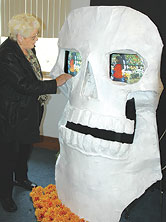 |
 |
|||||
 |
 |
 |
 |
 |
|||
 Mary Archbold checks out “A Celebration of Ancestors: Celtic Samhain, Mexican Day of the Dead and Other Cultural Memorial Issues” at the Irish-American Heritage Center Oct. 15. Catholic New World/ Sandy Bertog |
At the turning of the year
ll across the United States, children will dress up as superheroes and movie villains and traipse up and down the streets, ringing doorbells and demanding candy. Families will carve pumpkins and some will tell ghost stories. Mock graveyards with stones inscribed, “Here lies Tony, thrown by a pony,” will spring up like dandelions on front lawns. The connection between Halloween traditions and Christian faith seems tenuous at best—especially for a holiday once known as All Hallow’s Eve, the vigil of All Saints’ Day. Then again, the roots of the celebration lie in pre-Christian Celtic traditions, said Frank Crowley, curator of “A Celebration of Ancestors: Celtic Samhain, Mexican Day of the Dead and Other Cultural Memorial Rituals.” Samhain (pronounced “sow-when”) was a festival held at “the dreary time of year” when summer was over and winter was coming upon the people. As the days grew shorter and the nights grew colder, “the veil between the living and the dead was at its thinnest,” Crowley said. “The moveability—from the dead to the living and from the living to the dead—was there.” People dressed up and disguised their children to trick evil spirits and lit bonfires to scare them away. They also left treats for the departed souls to keep them happy. “The souls had to be appeased so they wouldn’t become troublesome,” Crowley said. As Ireland became Christian, the Pope Gregory IV moved the Feast of All Saints from May 13 to Nov. 1 in 835 AD, probably to coincide with the Samhain festivities, said Dennis Martin, an associate professor of historical theology at Loyola University Chicago. In doing so, he was following an established Christian practice of linking faith-based holidays to the timing of non-Christian festivals, starting with Gregory the Wonder Worker, who established Christian feasts on former pagan holidays in Asia Minor in the 200s, Martin said. “It was a deliberate transformation,” he said. “The people need to have a world, a society, a culture, and holidays and the calendar are a big part of the culture. And it’s a sacramental principle that everything God made is good, and that includes time and the calendar.” Spanish Christians brought the Feast of All Saints to the New World, where it transformed an Aztec celebration that has now become known as Day of the Dead, celebrated Nov. 1 and 2 in Mexico and increasingly in the United States. The Spanish shortened and moved the monthlong Aztec celebration from August to November, to coincide with the Feasts of All Saints and All Souls. Unlike the Celts of ancient Ireland and Scotland, the indigenous people of Mexico did not fear being visited by the souls of the departed. They welcomed them as much-missed members of the family, said Cesareo Moreno, a curator at the Mexican Fine Arts Center Museum of Chicago, which this year celebrates 20 years of having the largest Day of the Dead display in the United States. In rural Mexico, families still spend the night of Nov. 1 at the cemetery, waiting for the souls to arrive, he said. “It’s kind of like waiting for your family to arrive at the airport,” Moreno said. While they wait, they clean and decorate graves, eat, drink and socialize. At dawn, in many communities, they leave a trail of flower petals for the souls of their departed loved ones to follow on their way home. At home, they create an “ofrenda,” an altar or shrine, in memory of their dead. The displays often include pictures of the deceased, their favorite foods, items that they might have used, and religious pictures, whether of the Sacred Heart, Our Lady of Guadalupe or a local patron saint, Moreno said. It’s a popular tradition, not generally celebrated in church, Moreno said. “In Mexico, the priests don’t condemn it, but they don’t condone it, either,” he said. “Until recently, I had never seen an ofrenda in a church in Mexico. But in Chicago, where families cannot spend the night in the cemeteries and follow the tradition the way they would in Mexico, many parishes with significant Mexican populations have embraced it, creating ofrendas where worshippers can bring mementoes of their deceased loved ones, Moreno said. Martin questions the wisdom of allowing one of the church’s main feasts to be overshadowed by popular traditions. The Feast of All Saints is meant to honor Christ’s great victory over death, he said. The Feast of All Souls was always meant to be subordinate to All Saints’ Day, with an emphasis on praying for the souls in purgatory. “All Saints is a Catholic holiday,” he said, while Halloween and Day of the Dead have pagan roots. Now commercial interests are cutting off whatever ties they had to Christian faith—as they are with Christmas and Easter, too. “One has to work at keeping our holidays Christian,” he said. “Now there’s a tendency to paganize them.”
On the cover: An ofrenda honoring Chicago Police Officer Eric Soloria, a graduate of Quigley Seminary North and Loyola University Chicago, at the Mexican Fine Arts Center Museum through Dec. 10. The museum, at 1852 W. 19th St. in Chicago, is free and open 10 a.m.-5 p.m. Tuesday through Saturday. For information, call (312) 738-1503. Photo courtesy of Mexican Fine Arts Center Museum |
||
|
|
|||